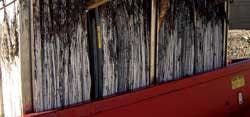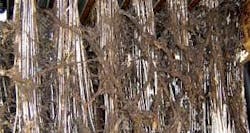Protecting Your MBR Investment: Role of Preliminary Liquids/Solids Separation is Significant
By Mike Woodley
Submerged membrane bioreactors (MBRs) are one of the fastest-growing treatment methods in wastewater. However, as is typical to all wastewater treatment processes, it is often the effectiveness of the preliminary liquids/solids separation operation, early in the influent's journey, that determines the efficiency of downstream processes.
MBRs combine key aspects of the activated sludge treatment process with a physical membrane liquids/solids separation operation. The membrane component uses low-pressure microfiltration or ultra filtration membranes to eliminate the need for clarification and tertiary filtration. Generally, the membranes are immersed in the aeration basin, although some applications use a separate membrane tank.
Aging infrastructure, more stringent effluent requirements and changing population demographics have driven dramatic growth in MBRs both in North America and throughout the world. Their increasing popularity results from the ability of MBR technology to achieve filtration at the micron level, as well as its ability to deliver high-quality effluent in considerably less space than a conventional wastewater treatment plant.
However, when planning a MBR-based treatment plant, one must balance preliminary liquids/solids separation options with issues such as cost, footprint, and energy consumption. Even though MBR technology is continuing to evolve and make improvements in the cost-of-ownership equation, today it is widely recognized that the cost of building and operating a MBR is typically higher than that of conventional processes. This additional cost is often mitigated, however, by the proven benefits of MBRs.
Need for Screening
While there are several types of membrane units, each depend on the preliminary liquids/solids separation operation of mechanical screening. Membranes are particularly vulnerable to non-biological suspended solids. These solids are a natural part of wastewater and arrive at the treatment facility in the form of trash, hair, plastics, rags and other physical contaminants. Such contaminants cause “fouling” or blockages, as well as matting amongst the membrane fibers. The results of this fouling can range from increased energy consumption to permanent damage to the membrane, causing its removal from service.
Fouling also causes other compromises in operational capabilities, including:
- restrictions to processing capacity
- costs and time for backwashing
- plant downtime when offline for replacement or maintenance.
It is the screening system – which typically accounts for less than three one-hundredths of the MBR investment – that must remove these potentially damaging physical contaminants from the process prior to introduction of the flow into the MBR bioreactor tank. It is the screen which must ensure material capture without bypassing or carryover to the downstream; and it is the screen and its efficacy that determines the demand for downstream maintenance.
When the Screens are Vulnerable, the MBR is Vulnerable
Several types of fine screening technology exist to protect membranes. The basic theorem accepted by those in the industry concludes that no pore size shall exceed 2mm in any direction. To that end, vertical/parallel screening elements (such as bars) are not desirable as they can allow passage of greater amounts of hair and other fouling agents. This leaves the choice of mesh or perforated materials for screening equipment.
A screen left alone will plug (worse with fine openings) — particularly with the grit, grease, hair, and other human refuse in the wastewater environment. Current technologies have several methods available to them for keeping screens clean: placing the element into the flow then removing to clean with a sprayer, brush, back flush, or some combination of these methods.
Awareness of both advantages and disadvantages of screening technologies has never been more critical than in handling the fine particulate that must be removed prior to MBR treatment. Independent of technology type, several key failure modes exist: blinding, leakage, tangling, and brush failure/deformation.
Binding
Binding refers to the state of a screen when all pores become clogged and cannot satisfactorily allow flow. Even with regular mechanical cleaning, a screen can still build contaminants that cause it to blind. Common culprits are grit and grease (wedging into fine pore openings) and fibrous debris (gathering in the back of the screen). In both of these cases, flow can be severely impeded. Typically, screens that become “blind” require removal from flow and aggressive cleaning.
Leakage
Leakage occurs when preliminary treatment allows debris to pass through openings larger than its pores. The potential for leakage can be found in several factors, including: improper installation; improper connection of the screen to the channel in which it resides (channel wall may not be square, or there may be a depression in the floor where the screening equipment rests); and other issues related to the screen itself.
Manufacturers have provided procedures to ensure that leakage caused by installation rarely becomes an issue. Sources of leakage stemming from the screening equipment itself are more difficult to correct, as most are inherent to equipment components.
Typically, leakage occurs when machine components become worn – for instance, seals and tracks used in most screening equipment are commonly made of plastic or rubber. Both of these materials are resistant to abrasion but tend to be weak mechanically and subject to wear. This may cause deflection and gaps, allowing debris to leak through the sealing surfaces. While it may seem overcautious to examine these small breaks in the seal, consider that 2mm is a small dimension, and it does not take long for a large surface to deflect 2mm or more.
When screening equipment fails (such as in the instance of leakage), debris continues on its path to downstream equipment. This may be a pump, grit chamber, or a membrane element. Pumps can be unclogged and grit chambers can be cleaned; however, membrane elements can be permanently damaged.
Tangling
Leakage and the passage of fibrous materials (such as hair) work together to form lengthy “strings”, which have a tendency to tangle around membrane supporting elements. These strings act as bridges on which fouling bacteria grow and spread onto the membrane surface. Ultimately, this debris can weave itself into the hollow fibers of the membrane element. Once this has occurred, it is nearly impossible to remove debris without cutting the membrane strands.
According to one experienced operator, “Rags build up, strangling the fiber and making it useless. We've lost 9 membranes at a cost of $40K each. Bottom line, you need the preliminary screening stage no matter what. Filter membranes require a good preliminary screening stage.” (Comments of Volker Franz of Anthem, Arizona.)
Brush Failure
Brush bristles are often subjected to stresses that exceed the creep strength of the brush material. As a result, brushes can form to the shape in which they are stressed. This deformation is permanent. Once this has occurred, the bristles will no longer sweep the face of the screen; instead, they are reduced to a smearing action.
Over time, this “loading” causes the bristle to deform, giving it a mashed or bent appearance. At a glance, this may not seem like a particularly serious problem; however, bending of the bristles is an indication that they have been stressed nearly to their breaking point. Wear now occurs much faster and if the brushes are not quickly replaced, their mounting hardware can wear through the screen element, causing leakage. This leakage can damage membrane elements.
Screen Types
Several approaches exist in fine screening for submerged membrane bioreactors; the first is a perforated or mesh material drum.
This type of screen is rotated about an axis parallel to the earth. As water is pumped into the drum, gravity causes it to continually drain through the pores of the screen. As the screen rotates, water pools at the bottom as debris clings to the wall of the drum. Screenings are brushed or sprayed off at the upper interior of the drum. Debris then falls to a conveyor, where it is transported to a de-watering process. Effluent is left clean and free of the debris that is larger than its pore openings.
The challenges of this arrangement include the necessity of pumped effluent and the relatively large size of the screens. Large, dynamic equipment such as the perforated or mesh material drum requires significant plant structures such as concrete bases, channels, pipes, electrical, pumps, valves and electronics. This approach, however, is the most robust on the market and has thus gained favor in MBR plant design and operation.
The second approach is similar, differing only in placement and size. The perforated or mesh material drum is placed into a concrete channel with an axis of rotation closer to vertical than horizontal. As the drum rotates, channel flow enters at one end and flows through. As with the horizontal perforated or mesh material drum screen, the drum is brushed and/or sprayed as it rotates; debris typically is discharged into an auger and carried up and out of the channel for de-watering, cleaning, compaction and disposal.
The main challenge of this approach lies in the screen's orientation. Water entering the drum can only reach a small portion of the usable screen area, making this a design best suited for relatively small plants.
The third approach uses a traveling water screen. This concept entails what is essentially a set of rectangular screen elements, joined at two edges by a hinge. These hinged elements form a continuous loop, which is constrained at both ends with a pulley or slide (driven similarly to a belt-type conveyor). Placed inside a channel, this mechanism is arranged so that one side is moving up as the other is moving down. The traveling water screen can be arranged in two ways: in an up/down motion that is perpendicular to the channel's length, making it a single-flow type; or parallel, making it a dual-flow type.
In the dual-flow type, water enters the end and leaves through the up/down traveling screen elements. In both types, water flows through the pores as the moving screen elements carry debris from the water. Once the screenings reach the top of the screen, they are removed from the screening element by a brush and/or water spray. The screenings then fall into a conveyance system for disposal.
The challenge with this concept lies in the large seals and tight tolerances that must be employed to avoid leakage. For example: panels must be guided and held while resisting hydrostatic forces, and as guides and seals are generally manufactured of rubber or plastic, the static and dynamic forces that screens are subjected to can cause wear and leakage. In addition, the downward-traveling panels must be sealed in a way that prevents binding of debris at the lower track or sprocket.
The fourth approach is to use an auger with attached brushes, sweeping debris from the mesh or perforated material; the auger/brushes in this method fit within the screen element, which is formed as a trough. The resultant mechanism is typically placed to protrude vertically from the bottom of the channel. Water flows through the screen as the auger rotates; brushes sweep the surface of the screen, pulling debris from the channel for disposal.
Maintenance of the brushes is the largest problem with this method, as this type of equipment can cause stress and eventual damage to the brush bristles.
Conclusion
The continuing growth in the application of MBR technology, and the reliance of MBR technology on efficient and effective preliminary liquids/solids separation in the form of screens, encourages the continuing search for improved methods. Screens, as with other types of physical and process equipment, will always have advantages and disadvantages that need to be weighed and considered in each application. However, you can be assured that the industry's equipment manufacturers will continue to search for better, easier ways to protect the world's MBRs. --m
About the Author:
Mike Woodley is the Research and Development Engineer for Duperon Corporation. He has a B.S. in mechanical engineering with a minor in computational mathematics. He has spent the last five years developing and improving screening solutions, and in his spare time enjoys CNC machining. He may be contacted at [email protected]



